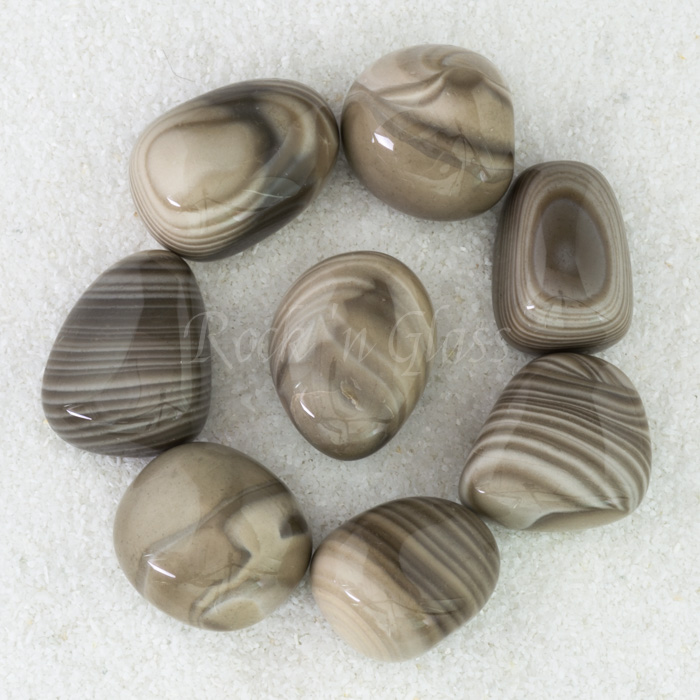Tumbled Stripped Flint
$8.00
SIZE: ~1.03” – 1.20”
Origin: Poland
Striped Flint: Manifest the spiritual into the physical with the divine power of flint
Price is for 1 stone. Multiple pieces are shown to demonstrate how no two are alike, differing in both size & shape.
6 in stock
A tumbled stone is a small, rounded, brightly polished stone. It can be any kind of crystal, mineral, fossil, or rock that has been rounded and polished either naturally or by human transformation.
How is a tumbled stone made?
Today, most tumbled stones are created by people using machines made specifically for the purpose of creating the beautifully polished stones. However, a similar effect can be and was achieved naturally for millions of years. The first tumbled stones were created by moving water in streams, rivers, and oceans. The currents of the water would wash grains of sand against small rocks to smooth and polish them naturally. Humans began attempting to further the process many years ago. Tumbled stones have been used and revered by humankind since prehistoric times. Ancient tribes would smooth stones for use in ceremonies or for healing or to wear as jewelry or in power bundles that pulsed with the magic inside the stones. In ancient Egypt, stones were placed in large troughs and moved back and forth through sand and water to smooth them. In India, a “polishing bag” was used for the same purpose. Stones were placed in a goatskin bag with finely ground rock. The bag was placed on the ground and pushed back and forth to smooth the stones. Sometimes the ancient Indian lapidaries employed a sort of teeter totter board to push the stones using the power of gravity as the board moved up and down. In the 1950s, Edward Swoboda began using a machine he devised to polish gemstones he couldn’t use in making fine jewelry and the modern tumbled stone was born. Others improved the tumbling device so that many stones could be tumbled at once. Today the stones are tumbled in huge barrels.
What is the purpose of tumbled stones?
Ancient humans used talismans and amulets, which included tumbled stones, as far back as prehistoric times. The use of talismans dates back to the Upper Paleolithic period around 60,000 years ago. The oldest known amulets were made at least 30,000 years ago and contained tumbled stones of Baltic Amber. Ancient Sumerians used tumbled crystals in magic formulae. Ancient Egyptians used tumbled stones for healing, to ward off evil, and in their burial ceremonies. The ancient Greeks and Romans used tumbled stones to ward of drunkenness and cure hangovers. Before battle, Greek and Roman soldiers would rub tumbled Hematite all over their bodies for protection in battle. Sailors would carry tumbled stones to assure safety at sea. The stones were worn or carried for luck, courage, success, and protection. In Asia, tumbled stones were carried for luck and to protect from evil spirits. Tumbled stones of various crystals and minerals are mentioned in much of the world’s important religious literature. During the Renaissance, tumbled stones were used for healing, strength, protection, and fertility. In modern times, tumbled stones are used for many similar purposes. They are used for healing, energy, chakra cleansing, to attract luck, to prevent psychic attack, to advance spirituality, to enhance meditation, to promote positive energy, to enhance public speaking, and for many more purposes
How can tumbled stones benefit you?
Tumbled stones are beautiful. The stones can be collected simply because they add beauty to your surroundings in your home, office, or garden. But there is so much more to these beautiful stones. They hold and emit vibrations that can be helpful to you in so many ways. If the ancients are right, as they so frequently are, then they can surround you with protection from negativity or attract success and abundance. You can place them in your home, office or garden not just for their beauty, but to surround yourself with a peaceful vibration that adds tranquility to your life or a protective shield from negativity or bad energy. You can wear or carry a bundle with the stones to protect you and aid you as you traverse the world. You need to examine the qualities that others have observed to occur from the different stones and choose the effect that best suits your purposes.
Be the first to review “Tumbled Stripped Flint” Cancel reply
Related products
Tumbled & Polished Crystals and Stones
Tumbled & Polished Crystals and Stones
Tumbled & Polished Crystals and Stones
Tumbled & Polished Crystals and Stones
Tumbled & Polished Crystals and Stones
Tumbled & Polished Crystals and Stones
Tumbled & Polished Crystals and Stones
Tumbled & Polished Crystals and Stones












Reviews
There are no reviews yet.